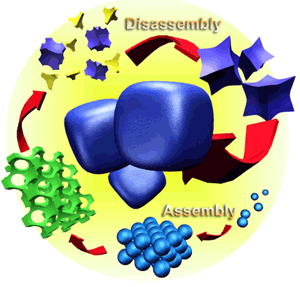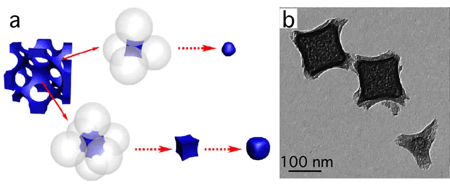Molding Porous Nanoparticles
Recent Research from Professor Andreas Stein and his
research group.
Within the last
few years, nanoparticles have transitioned from scientific curiosities
to becoming essential components in applications such as sensing, nanoelectronics,
catalysis and other uses. Their unique optical, electronic, magnetic and
reactive properties compared to bulk solids rely on control over both the
size of the particles in the nanometer size-regime and the particle shapes.
But how can the synthetic chemist control shapes on such a small scale?
Graduate student Fan Li in the Stein group recently
developed a novel approach for preparing monodisperse, discrete nanoparticles
with specific shapes (e.g., cubes, tetrapods, spheres). These shaped particles
can be porous, thereby significantly enhancing surface areas of the particles
and opening up possibilities for host-guest applications (e.g., sensors).
The method is based on a combination of self-assembly and templating methods
in tandem with controlled disassembly of porous solids into their structural
building blocks (Figure 1).

Figure
1. Porous
silica nanocubes and tetrapods are produced when a bottom-up synthesis
based on natural assembly/templating methods is combined with a top-down
synthesis involving structural disassembly. Uniform polymer nanospheres
are assembled into close packed arrays like marbles in a box. The space
between spheres is filled with precursors. During heating the polymer
spheres are removed and a solid spongy skeleton forms. Under the appropriate
reaction conditions, the skeleton breaks down into uniform building blocks.
Shaped silica
nanoparticles are prepared by controlled disassembly of a solid skeleton
that is built around a scaffold of close-packed nanospheres. The skeletal
structure consists of two basic units, cubes and tetrapods, which correspond
to the space between the packed nanospheres and are connected like tinker-toys.
Fan Li discovered that these building blocks can be disconnected and isolated
under specific synthesis conditions (Figure 2). The disassembly occurs
first by thinning of the necks between the two units, followed by complete
disconnection of the skeleton at the narrowest connection points. Discrete
nanoparticles are obtained in high yield. Their sizes are easily controlled
by the diameters of the templating nanospheres. The sponge-like silica
nanocubes and tetrapods can themselves be used as molds to produce similar
particles made of carbon or polymers. This general method of preparing
uniform porous nanoparticles with specific shapes is described in an upcoming
issue of Angewandte Chemie, International Edition and is featured on the
journal cover.

Figure
2. (a) Illustration of the disassembly of a porous
skeleton structure into its building blocks. (b) Transmission electron
microscopy image of carbon replicas of the porous silica cubes and tetrapods.
|